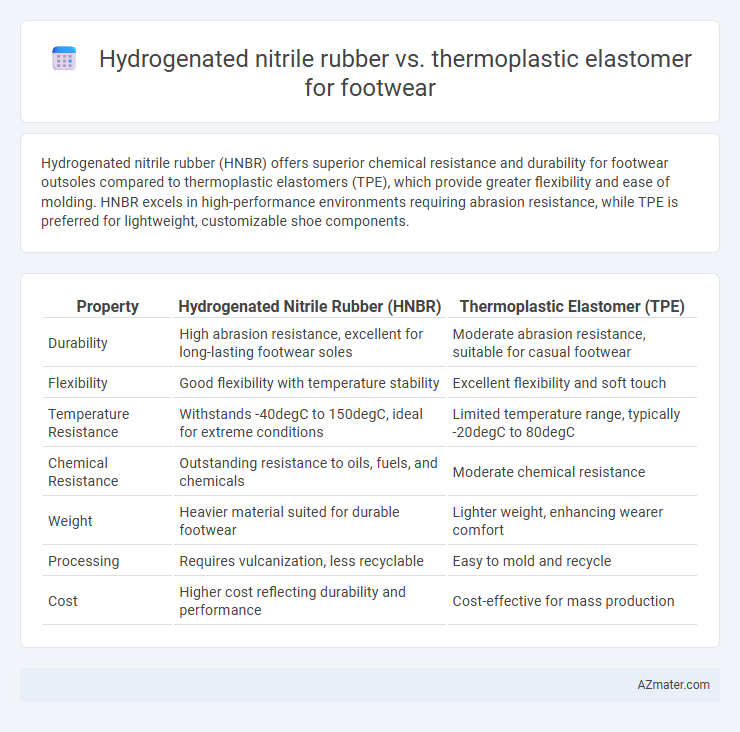Hydrogenated nitrile rubber (HNBR) offers superior chemical resistance and durability for footwear outsoles compared to thermoplastic elastomers (TPE), which provide greater flexibility and ease of molding. HNBR excels in high-performance environments requiring abrasion resistance, while TPE is preferred for lightweight, customizable shoe components.
Table of Comparison
| Property | Hydrogenated Nitrile Rubber (HNBR) | Thermoplastic Elastomer (TPE) |
|---|---|---|
| Durability | High abrasion resistance, excellent for long-lasting footwear soles | Moderate abrasion resistance, suitable for casual footwear |
| Flexibility | Good flexibility with temperature stability | Excellent flexibility and soft touch |
| Temperature Resistance | Withstands -40degC to 150degC, ideal for extreme conditions | Limited temperature range, typically -20degC to 80degC |
| Chemical Resistance | Outstanding resistance to oils, fuels, and chemicals | Moderate chemical resistance |
| Weight | Heavier material suited for durable footwear | Lighter weight, enhancing wearer comfort |
| Processing | Requires vulcanization, less recyclable | Easy to mold and recycle |
| Cost | Higher cost reflecting durability and performance | Cost-effective for mass production |
Introduction to Footwear Material Selection
Hydrogenated nitrile rubber (HNBR) offers exceptional resistance to oils, heat, and abrasion, making it suitable for durable and high-performance footwear components such as outsoles and midsoles. Thermoplastic elastomers (TPE) combine the elasticity of rubber with the processing ease of plastics, providing lightweight, flexible, and recyclable options ideal for comfort-focused footwear applications. Material selection in footwear emphasizes balance between durability, flexibility, cost, and environmental impact to meet specific performance criteria and user needs.
Overview of Hydrogenated Nitrile Rubber (HNBR)
Hydrogenated nitrile rubber (HNBR) is a synthetic elastomer known for its exceptional resistance to heat, oil, and abrasion, making it highly durable for demanding footwear applications. Its hydrogenation process enhances chemical stability and aging resistance compared to standard nitrile rubber, providing superior performance in environments exposed to harsh conditions. HNBR's elasticity and robustness contribute to long-lasting, comfortable footwear components such as outsoles and midsoles, outperforming many thermoplastic elastomers (TPEs) in durability and resilience.
Introduction to Thermoplastic Elastomer (TPE)
Thermoplastic elastomers (TPE) are widely used in footwear for their excellent flexibility, durability, and ease of processing compared to hydrogenated nitrile rubber (HNBR). TPE materials offer superior resistance to wear, chemicals, and temperature variations, making them ideal for midsoles, outsoles, and flexible components in shoes. Their recyclability and ability to be molded in complex shapes with high precision optimize manufacturing efficiency and environmental sustainability in footwear production.
Mechanical Properties: HNBR vs TPE
Hydrogenated nitrile rubber (HNBR) exhibits superior abrasion resistance, tensile strength, and resilience compared to thermoplastic elastomers (TPE), making it ideal for footwear components subjected to high wear and mechanical stress. HNBR maintains excellent flexibility and elasticity over a broad temperature range, whereas TPEs generally offer better processability and softer touch but lower mechanical durability. The enhanced chemical and oil resistance of HNBR contributes to longer lifespan and performance in demanding environments, contrasting with TPEs which prioritize lightweight and recyclability for casual footwear applications.
Durability and Wear Resistance Comparison
Hydrogenated nitrile rubber (HNBR) offers superior durability and wear resistance in footwear applications due to its excellent chemical stability, heat resistance, and abrasion resistance, making it ideal for high-performance and long-lasting shoes. Thermoplastic elastomers (TPEs), while flexible and cost-effective, generally provide lower wear resistance and tend to degrade faster under harsh environmental conditions compared to HNBR. The enhanced elasticity and resilience of HNBR contribute to prolonged footwear lifespan, especially in industrial and outdoor environments where exposure to oils and extreme temperatures is common.
Flexibility and Comfort Differences in Footwear
Hydrogenated nitrile rubber (HNBR) offers superior flexibility and excellent resistance to wear, making it ideal for durable, high-performance footwear requiring long-lasting comfort and resilience. Thermoplastic elastomers (TPE) provide good flexibility with the added benefit of ease in molding and recycling, often resulting in lightweight shoes that enhance comfort through better shock absorption and cushioning. While HNBR excels in long-term flexibility and durability in extreme conditions, TPE footwear typically prioritizes immediate comfort and adaptability to foot movements.
Chemical and Environmental Resistance
Hydrogenated nitrile rubber (HNBR) exhibits superior chemical resistance to oils, fuels, and solvents compared to thermoplastic elastomers (TPE), making it ideal for footwear exposed to harsh industrial conditions. HNBR also offers excellent resistance to ozone, oxidation, and high temperatures, enhancing durability in demanding environments, whereas TPEs generally provide moderate chemical resistance but excel in flexibility and recyclability. Environmentally, TPEs are more sustainable due to their thermoplastic nature, enabling easier recycling and lower environmental impact, while HNBR's synthetic rubber composition poses challenges for eco-friendly disposal.
Manufacturing Process and Cost Efficiency
Hydrogenated nitrile rubber (HNBR) offers superior chemical resistance and durability, making it ideal for high-performance footwear, but its manufacturing process involves complex vulcanization that increases production time and costs. Thermoplastic elastomers (TPE) benefit from simpler, faster injection molding processes that eliminate vulcanization, resulting in enhanced manufacturing efficiency and lower overall costs. Cost efficiency in footwear production often favors TPE due to reduced cycle times and recyclability, while HNBR is preferred when long-term wear resistance justifies higher initial investment.
Sustainability and Recycling Considerations
Hydrogenated nitrile rubber (HNBR) offers superior durability and resistance to oils, extending footwear lifespan and reducing waste through fewer replacements. Thermoplastic elastomers (TPE) provide enhanced recyclability due to their thermoplastic nature, allowing multiple remelting and reshaping cycles, which supports circular economy goals in footwear production. Sustainable footwear design benefits from selecting HNBR for performance longevity and TPE for end-of-life material recovery, balancing environmental impact with functional requirements.
Best Applications: Choosing the Right Material for Footwear
Hydrogenated nitrile rubber (HNBR) offers superior oil resistance, tensile strength, and durability, making it ideal for rugged outdoor footwear and work boots requiring enhanced protection and longevity. Thermoplastic elastomers (TPE) provide excellent flexibility, lightweight comfort, and ease of molding, suited for casual and athletic shoes emphasizing comfort and design versatility. Selecting between HNBR and TPE depends on footwear application demands, balancing durability and performance versus comfort and aesthetics.

Infographic: Hydrogenated nitrile rubber vs Thermoplastic elastomer for Footwear
 azmater.com
azmater.com